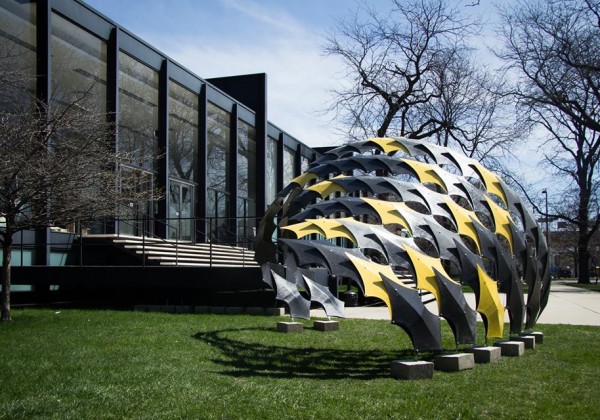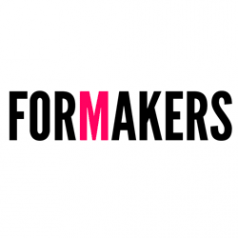09MAY 2014
 © College of Architecture / IIT Why carbon fiber? Carbon fiber material is a flexible and malleable cloth that can be cut with scissors and easily formed and fit over three dimensional molds. When coated and cured with an epoxy resin, it can become hard as steel. Layers and layers can be added to enhance strength, giving the designer great control over structural properties while remaining incredibly light weight.
© College of Architecture / IIT Why carbon fiber? Carbon fiber material is a flexible and malleable cloth that can be cut with scissors and easily formed and fit over three dimensional molds. When coated and cured with an epoxy resin, it can become hard as steel. Layers and layers can be added to enhance strength, giving the designer great control over structural properties while remaining incredibly light weight.
 © College of Architecture / IIT Carbon fiber’s amazing adaptive qualities have already been extensively utilized within the automotive and aerospace industries.
We think it’s time architects join the game.
Through the fabrication of a full scale carbon fiber pavilion, our goal is to showcase the great potential composite materials can bring to architectural expression. The pavilion design is comprised of one geometric unit ‘the shell’ repeated sixty times.
© College of Architecture / IIT Carbon fiber’s amazing adaptive qualities have already been extensively utilized within the automotive and aerospace industries.
We think it’s time architects join the game.
Through the fabrication of a full scale carbon fiber pavilion, our goal is to showcase the great potential composite materials can bring to architectural expression. The pavilion design is comprised of one geometric unit ‘the shell’ repeated sixty times.
 © College of Architecture / IIT The shell connects laterally at two points to another shell on either side with metal rings, creating flexible rows. The rows are then connected vertically by another set of rings. A specific pattern of row length and vertical connections creates a curving wavelike structure, we call it FIBERwave.
© College of Architecture / IIT The shell connects laterally at two points to another shell on either side with metal rings, creating flexible rows. The rows are then connected vertically by another set of rings. A specific pattern of row length and vertical connections creates a curving wavelike structure, we call it FIBERwave.
 © College of Architecture / IIT Tension cables running through the connected shells give the structure its shape. The nature of the ring connection and the shell geometry allows the pavilion to undulate and morph. When the tension cables are pulled tight the shells interlock and press against each other, opening the pavilion to its fullest height.
© College of Architecture / IIT Tension cables running through the connected shells give the structure its shape. The nature of the ring connection and the shell geometry allows the pavilion to undulate and morph. When the tension cables are pulled tight the shells interlock and press against each other, opening the pavilion to its fullest height.
 © College of Architecture / IIT When the cables are loosened, the structure relaxes and closes. FIBERwave in this sense is an adaptive parametric model, designed to change and react to its environment over time.
Carbon_Lab aims to challenge static processes within design practice and culture. We hope to explore new materials and inspire innovative procedures that push the boundaries of parametric thinking and produce meaningful and high performance results.
© College of Architecture / IIT When the cables are loosened, the structure relaxes and closes. FIBERwave in this sense is an adaptive parametric model, designed to change and react to its environment over time.
Carbon_Lab aims to challenge static processes within design practice and culture. We hope to explore new materials and inspire innovative procedures that push the boundaries of parametric thinking and produce meaningful and high performance results.
 © College of Architecture / IIT Our intent is to become an expert resource in working with composites. Doing so requires a high level of digital modeling, fabrication, craft skills and attention to detail. A few of the exciting reasons for exploring the possibilities of composites within architecture are their ability to build lightweight, dynamic and easily variable strength structures.
© College of Architecture / IIT Our intent is to become an expert resource in working with composites. Doing so requires a high level of digital modeling, fabrication, craft skills and attention to detail. A few of the exciting reasons for exploring the possibilities of composites within architecture are their ability to build lightweight, dynamic and easily variable strength structures.
 © College of Architecture / IIT.
© College of Architecture / IIT.
 © College of Architecture / IIT
© College of Architecture / IIT
 © College of Architecture / IIT
© College of Architecture / IIT
 © College of Architecture / IIT
© College of Architecture / IIT
 © College of Architecture / IIT
© College of Architecture / IIT
 © College of Architecture / IIT
© College of Architecture / IIT
 © College of Architecture / IIT
© College of Architecture / IIT
 © College of Architecture / IIT
© College of Architecture / IIT
FIBER wave Pavilion / College of Architecture / IIT
Posted in Events_Interviews - Events_Interviews by * FORMAKERS
Carbon_Lab is a student based design research studio within the College of Architecture at the Illinois Institute of Technology devoted to the study of performative and adaptive physical fabrication. Our studio’s current focus is engaged in working with composite fiber materials, specifically carbon fiber, and utilizing their unique properties within architectural design. © College of Architecture / IIT
© College of Architecture / IIT © College of Architecture / IIT
© College of Architecture / IIT © College of Architecture / IIT
© College of Architecture / IIT © College of Architecture / IIT
© College of Architecture / IIT © College of Architecture / IIT
© College of Architecture / IIT © College of Architecture / IIT
© College of Architecture / IIT © College of Architecture / IIT
© College of Architecture / IIT © College of Architecture / IIT
© College of Architecture / IIT
 © College of Architecture / IIT
© College of Architecture / IIT
 © College of Architecture / IIT
© College of Architecture / IIT
 © College of Architecture / IIT
© College of Architecture / IIT
 © College of Architecture / IIT
© College of Architecture / IIT
 © College of Architecture / IIT
© College of Architecture / IIT
 © College of Architecture / IIT
© College of Architecture / IIT
Comments
No comments
Sign in »




